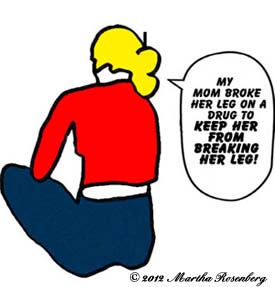 Like Vioxx, Merck’s expensive “super aspirin” that caused thousands of cardiovascular events before being recalled, Merck’s Fosamax, the first bisphosphonate bone drug, flew out of the FDA with only a six-month review.
Like Vioxx, Merck’s expensive “super aspirin” that caused thousands of cardiovascular events before being recalled, Merck’s Fosamax, the first bisphosphonate bone drug, flew out of the FDA with only a six-month review.
And like Vioxx, the true dangers of the drug class (that includes Fosamax, Boniva and Reclast) only surfaced after being “tested” on the guinea pig known as Jane Q Public.
Now, people are asking why the bone drugs were ever approved.
Like Vioxx, there were early indications of Fosamax’s risks but they did not prevent wide marketing. Merck received 1,213 adverse-effect reports soon after the drug’s approval, which included 32 hospitalized patients with adverse esophageal effects, 17 with “severe” effects, and two who were “temporarily disabled,” reported the New England Journal of Medicine. One woman who took Fosamax and only remained upright for 30 minutes not 60 minutes as directions say, had to be admitted to the Mayo Clinic with “severe ulcerative esophagitis affecting the entire length of the esophagus” and had to be fed intravenously.
And there were other safety signals. Bisphosphonate patients were found to be at greater risk for osteonecrosis of the jaw—death of the jawbone—after in-office dental procedures. They were found to be at greater risk for irregular heartbeat, intractable pain and at double the risk of esophageal cancer, according to medical reports.
Then, in 2010, after millions of women were taking the widely advertised bisphosphonates, studies revealed they sometimes caused the very fractures they were supposed to prevent!
“Long-term use of osteoporosis drugs linked to hip breaks,” said USA Today. “Increased risk of fracture with bisphosphonates,” said the Associated Press. “Drugs to build bones may weaken them,” said the New York Times, which reported that the thigh bones of patients on bisphosphonates have “simply snapped while they were walking or standing,” after “weeks or months of unexplained aching.”
Soon after the FDA met in 2011 to determine how long patients could safely remain on the drugs (assuming they were safe at all), an article in New England Journal of Medicine suggested that 90 percent of women who have been getting bone scans, devised by Big Pharma to sell bone drugs say published reports, did not need them. Oops.
In April, a study in the Canadian Medical Association Journal found patients on bisphosphonates were at higher risk of developing the eye disorders scleritis and uveitis. And this week the FDA announced that the bisphosphonates may stop working after a while. The FDA’s analysis “found little if any benefit from the drugs after three to five years of use,” reported the New York Times.
As many as 60 percent to 70 percent of current users “would be candidates for stopping the drugs after three to five years,” reports the Times—a diplomatic way of saying they were taking drugs for naught.
Why did the FDA rush to approve bone drugs which turned out to have links to cancer, jawbone death, heart problems, intractable pain and eye disorders? Drugs which actually cause fractures and apparently cease working while patients take them? Why did it foster Merck’s apparent marketing plan of making quick money before risks surfaced? See: Vioxx?
 Martha Rosenberg’s first book, “Born with a Junk Food Deficiency: How Flaks, Quacks, and Hacks Pimp the Public Health,” was released last week. She is a freelance writer and editorial cartoonist. She has been a frequent contributor to the San Francisco Chronicle, the Providence Journal, and the Chicago Tribune. She has also contributed to the Boston Globe, the Los Angeles Times, Newsday, Arizona Republic, the New Orleans Times-Picayune, the Atlanta Journal-Constitution, Pittsburgh Post-Gazette, and Consumers Digest. In addition, she is a regular health columnist on the Huffington Post, AlterNet, Intrepid Report, CounterPunch, BuzzFlash, Foodconsumer, NewsBlaze, YubaNet, Scoop, and the Epoch Times.
Martha Rosenberg’s first book, “Born with a Junk Food Deficiency: How Flaks, Quacks, and Hacks Pimp the Public Health,” was released last week. She is a freelance writer and editorial cartoonist. She has been a frequent contributor to the San Francisco Chronicle, the Providence Journal, and the Chicago Tribune. She has also contributed to the Boston Globe, the Los Angeles Times, Newsday, Arizona Republic, the New Orleans Times-Picayune, the Atlanta Journal-Constitution, Pittsburgh Post-Gazette, and Consumers Digest. In addition, she is a regular health columnist on the Huffington Post, AlterNet, Intrepid Report, CounterPunch, BuzzFlash, Foodconsumer, NewsBlaze, YubaNet, Scoop, and the Epoch Times.



Pingback: India’s backward traditional medical system! « Quick Take – As It Happens
Fantastic goods from you, man. I’ve be mindful your stuff previous to and you are simply too great. I actually like what you have got right here, certainly like what you are stating and the way in which you assert it. You’re making it enjoyable and you still care for it to stay sensible. I cannot wait to read far more from you. That is actually a tremendous website.